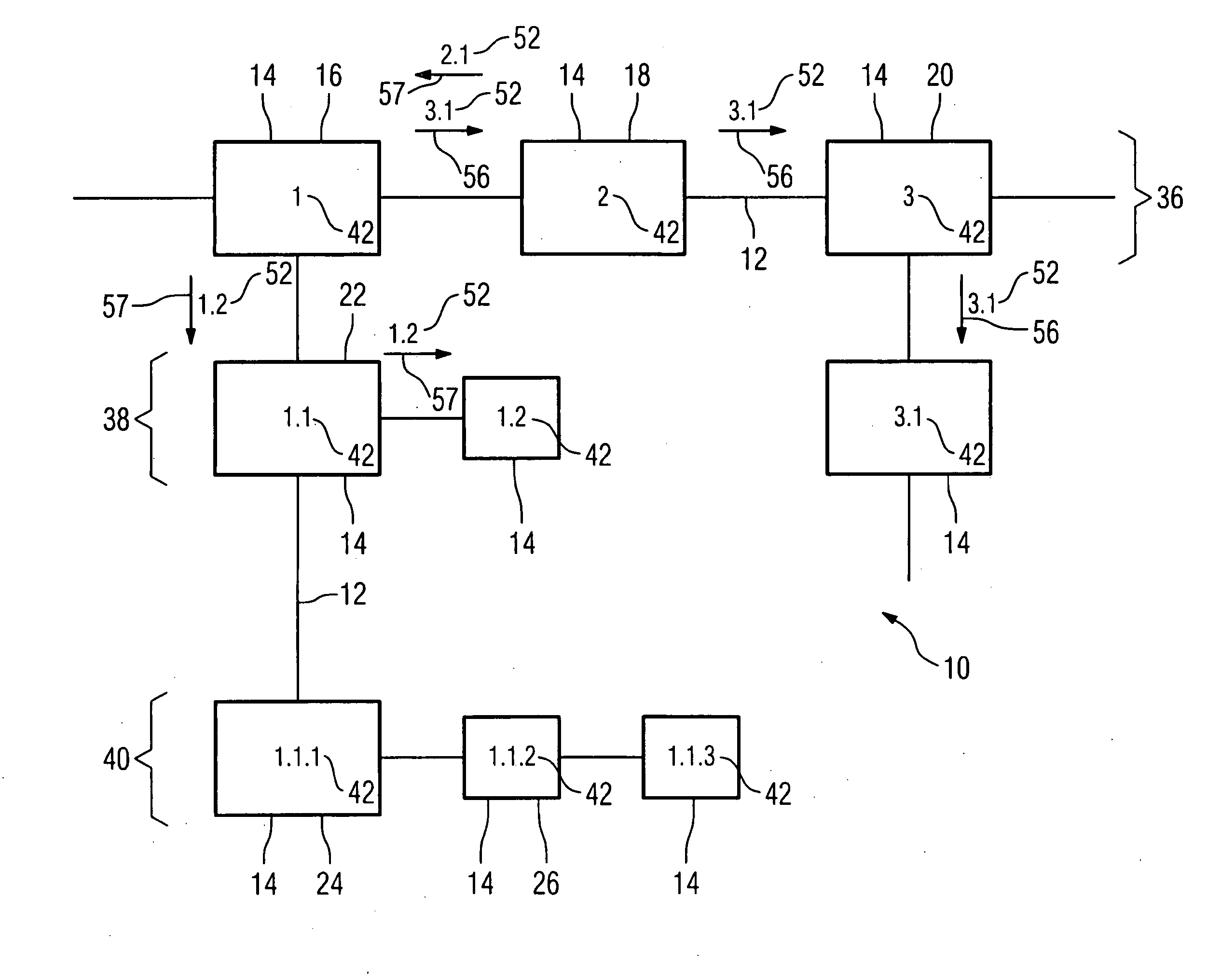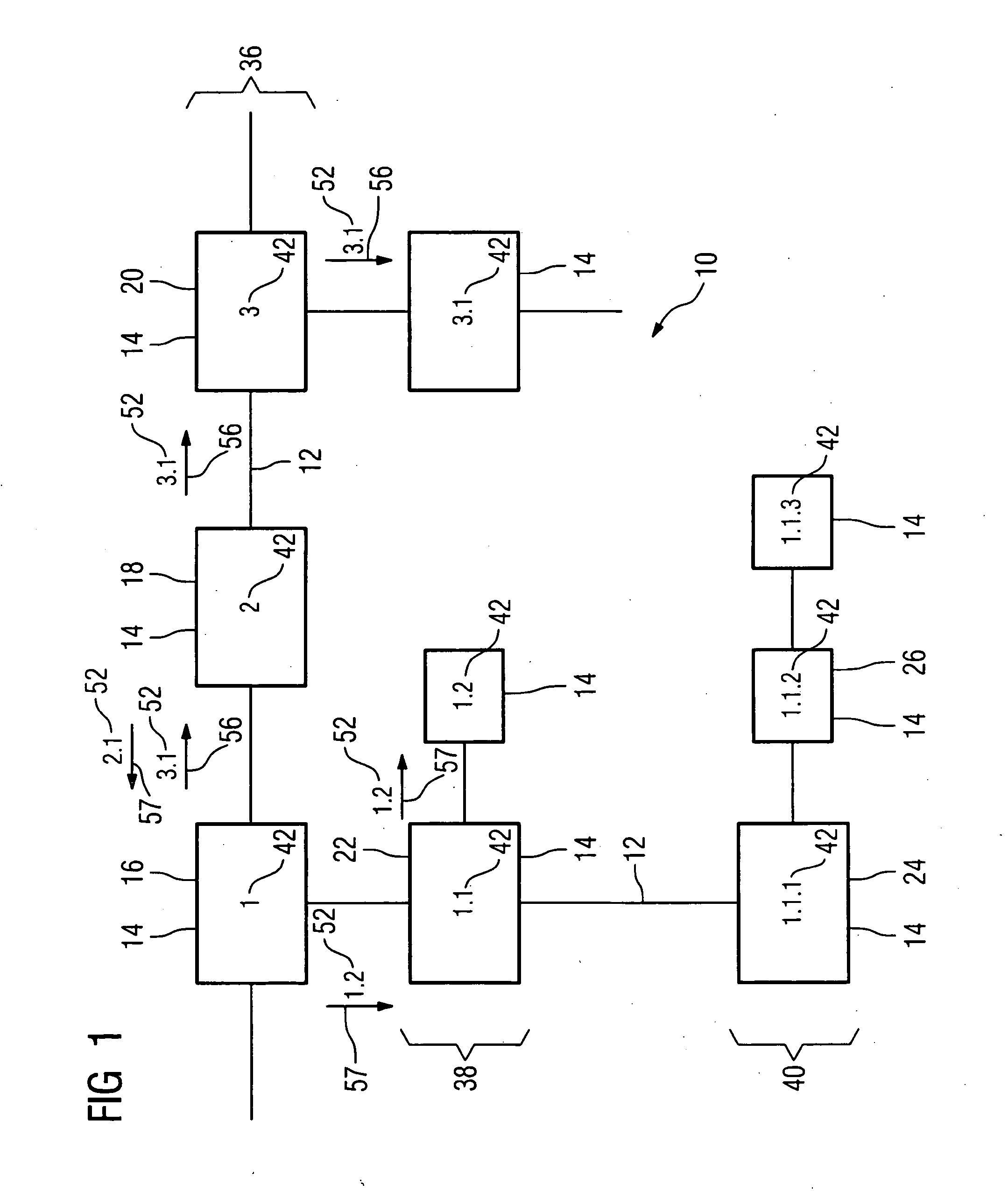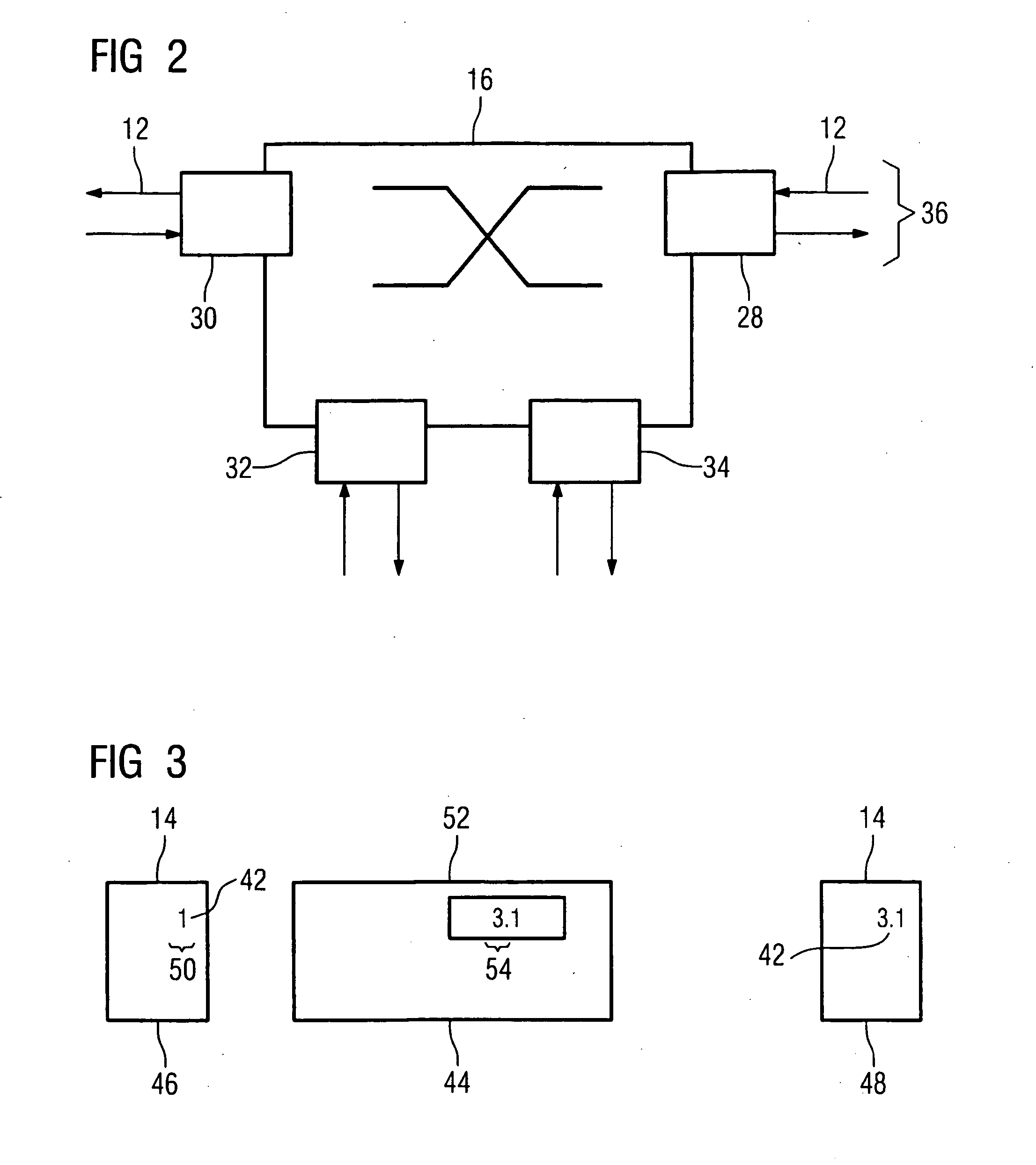[0009]The network is seen as being organized in lines, with a first line being assigned to a central communications subscriber, e.g. a higher-order
station in the form of a master computer or the like. A number of communications subscribers can be provided within one line, at least some of them being configured as network components of the type mentioned above or at least some of them having such a functionality. The first and second ports function here as an input or output depending on the direction of telegrams to be transferred by way of the network. By connecting the individual ports, in other words by connecting the first port of a first network component, to the second port of a subsequent further network component, the communications subscribers, in particular the network components, are connected one behind the other within the same line. All the connections which result from connection to the first or second port of the above-mentioned network components are considered to be associated with a hierarchically identical line. An interface with other communications subscribers in the automation system, in particular other network components, is possible by way of the third and optionally further ports. These communications subscribers or network components no longer belong to the line with which the network component is associated, by way of the third port of which the connection is established. Every communications subscriber connected in this manner is considered to be associated with a hierarchically lower-order line. If the communications subscriber connected in this manner is a network component of the type mentioned in the introduction, the hierarchically lower-order line can be extended to become an actual line, in other words a
network segment with more than two communications subscribers, by connecting further communications subscribers, in particular network components, to its second port. If the communications subscriber connected in the above-mentioned manner is a network component of the type mentioned in the introduction, an again hierarchically lower-order line can be provided by connection to its third port, etc. The dedicated use of the ports known per se with network components on the one hand for connections within a hierarchically identical line and on the other hand for connections to a hierarchically lower-order line results in a unique structure in the automation system, allowing the destination-specific forwarding of telegrams.
[0011]An
alias for example is then preferably assigned to the master computer mentioned in the introduction, indicating the latter's central position in the automation system, e.g. in the form of a figure or a so-called string with the value or content “1”. Telegrams sent between individual communications subscribers in the automation system then designate a destination communications subscriber at least based on its
alias as well. When a network component receives a telegram a specific alias is compared on this basis with an alias of a destination communications subscriber included in the received telegram, hereafter referred to simply as a destination alias. Depending on the result of the comparison the telegram is then forwarded either by way of the first, second or third port or any other ports. In other words the comparison of the specific alias and destination alias allows the unique selection of one of the ports of a network component for forwarding the received telegram by way of the port resulting specifically from the comparison.
[0017]To select a communications path to the destination communications subscriber no data, in particular no data in the manner of an FDB or similar used hitherto in the prior art, has to be held ready in the network components involved, so the load on the network components is reduced in this respect. Also the communications path to the respective communications subscriber can be determined fully at any time, regardless of whether the addressed destination communications subscriber has already identified itself to adjacent communications subscribers, in particular to network components, as required to set up an FDB. In this respect the network, in other words the automation system, is relieved of unnecessary communication, which results in the prior art in particular when a destination communications subscriber is not yet known so that the relevant network component has to forward the received telegram to all available ports to be sure of reaching the destination communications subscriber.
[0025]To this extent the invention also relates to a method for transmitting data in an automation system with a number of communications subscribers, of which at least individual ones are embodied as network components of the type described here or as network components that are operated or can be operated according to the method described here. With this method each network component orders telegrams, which it has received for forwarding to a respective destination communications subscriber, taking into consideration at least the component of the alias of the destination communications subscriber (destination alias) included in each such telegram and designating a specific level of the network component. A network component with the alias “2.3”, which can thus already be identified as associated with a hierarchically second level, therefore orders telegrams which it receives and which are intended for forwarding to destination communications subscribers with the alias “2.4”, “2.6”, “2.6.1”, “2.7” according to the alias component belonging to this second level, i.e. “4”, “6”, “6” and “7”. A compacted frame (compacted telegram) is formed on the basis of the telegrams thus ordered by lining them up and combining them in a
single frame instead of the individual frames hitherto transmitted for each telegram. This compacted frame is forwarded instead of the individual frames received during a predetermined or predeterminable time period. The
advantage of this aspect of the invention, which is optionally independently patentable, is that in an automation system, in which an alias is or can be assigned to each communications subscriber according to the formation system described above, it is possible to use these designators, which as designators of the respective destination communications subscriber are also contained in sent telegrams, to order the
payload, in other words datagrams, contained in such telegrams easily in such a manner as they are “consumed”, i.e. received and evaluated, along the respective line by the communications subscribers associated with this line. A compacting of telegrams by lining up a number of individual telegrams or the
payload contained therein is known per se but the significant aspect here is that the
payload in the compacted telegram is also arranged in a sequence based on the topology of the communications subscribers, so that simple conditions prevail for the consumption of the individual payload. The
advantage is that only one message, in other words only the compacted telegram, has to be handled and with this one telegram it is possible to reach a number of destination communications subscribers so that even complex automation structures can be managed reliably. Also data
throughput is optimized by dynamizing the frame structure and decoupling sending and receiving.
[0027]In the case of compacted telegrams, in other words long frames resulting from a combination of a number of individual datagrams which are therefore extensive, it can happen that a first communications subscriber could already extract datagrams at a time when the complete transmission of the compacted telegrams by the sending communications subscriber in each instance has not yet been terminated. Normally on
receipt of a telegram a communications subscriber would await
receipt of a check code provided at the end of the telegram, verify the
correctness of the check code and only then access the contained payload. If in the case of long telegrams payload is already present with a first recipient at a time when the transfer of the telegram has not yet been completely terminated by the current sender, with the situation until now the recipient is not yet able to access the payload, as it cannot yet be verified based on the check code which is not yet present. It is necessary then to await full
receipt of the telegram and buffer it. To avoid this
disadvantage, provision is advantageously made for specific check data to be assigned to each
datagram in a compacted telegram. It is thus possible for all payload, for which this check data is already present with the respective recipient, to be verified on the basis of the check data and optionally consumed. It is not necessary to await receipt of the check code in some instances still present at the end of the compacted telegram. The provision of check data for every
datagram included in the telegram therefore allows early access to the payload contained in the telegram so that communication can also be accelerated, in that for example the respective
datagram is immediately consumed or provided for forwarding to subsequent communications subscribers.
[0028]In combination with accelerated forwarding and an advantageous arrangement of the datagrams this method also supplies a high level of efficiency.
Processing of the datagrams can be carried out at the same rate as forwarding, so that only one factor, i.e. just the duration of
processing or just the duration of forwarding, becomes influential when calculating the arrival of a datagram at the respective destination communications subscriber.
 Login to View More
Login to View More  Login to View More
Login to View More 


